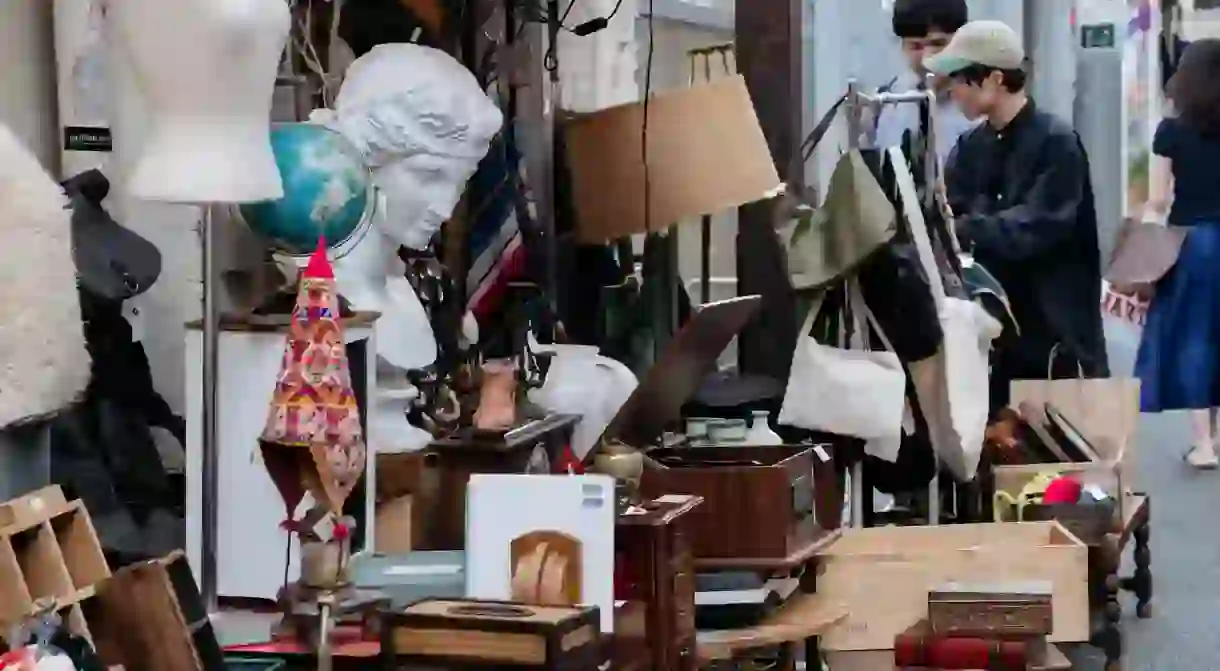A Complete Neighbourhood Guide to Shimokitazawa

Shibuya has the crossing, Shinjuku has its neon-drenched streets and Harajuku has its fashion, but if you’re after something a little more laid-back and bohemian in style, Shimokitazawa is the Tokyo suburb you need to get to know. This once farming suburb has gone through a number of reinventions in the past few decades and shows no sign of slowing down. Located only a few stops from the heart of Tokyo, this pocket of Setagaya Ward is a local favourite.
History
A little more humble than some of its neighbouring suburbs, Shimokita (to the locals) was actually born as a farming community. The area began its residential evolution following the devastating 1921 Great Kanto earthquake, when many of the inner city’s population moved further out to avoid potential dangers of living in such a dense urban environment. Following that, the area survived the destructive forces that were WWII and saw the area become a small market hub for US soldiers following the war.

The more contemporary image of Shimokita that we see today can really be traced back to the 1970s and ’80s, when the more alternative Tokyo youth were inspired to move further from the city to be able to afford their creative lifestyles.

Transport
Though in a lot of ways it feels worlds away from the billboard-lined streets of Shinjuku and the fast paced traffic of Shibuya, Shimokita is actually very central to the cultural heart of modern Tokyo. The main station services two train lines, the Odakyu line and the Keio Inokashira line.

If you’re travelling from Shinjuku, Tokyo’s main station, it’s an easy seven-minute journey on the Odakyu and will cost you about 160 yen (US$1.60). If Shibuya is your station of departure, it’s even quicker, as the express train on the Keio Inokashira line will take you from the heart of Shibuya to central Shimokita in about three minutes and will cost 130 yen (US$1.30).


Food
Shimokita, like pretty much every other central hub of Tokyo, is a very accessible food-lover’s paradise. The area doesn’t have any real specialty when it comes to dishes and cuisine, but if trendy yet affordable cafés are what you’re after, it’s a pretty safe bet. Otherwise, what you can eat in Shimokita really depends on what you feel like. There are plenty of Japanese fast-food style outlets covering all the typical ground – ramen, sushi, udon and soba.

If you’re after a bit more of a dining ‘experience’, check out Shimokita Cage located under the train tracks just a few minutes walk from the station. Shimokita Cage is a long-term pop-up dining venue that’s set to run until 2019. Here, the space hosts a rotating cast of food trucks, as well as their own more permanent kitchen. Don’t let its wire-clad, prison-like façade scare you away, the Cage is actually one of the most welcoming communal dining spaces in the city.
If it’s traditional style dining you’re after, check out Izakaya Ism. This much loved local icon is a great place to get a little rowdy. Featuring classic izakaya-style dining and affordable booze, it does get pretty popular, so maybe expect a wait, but once you get in it’s worth it.
Shimokita Cage: 〒155-0031 Tokyo, Setagaya, Kitazawa, 2 丁目6−2, +81 3 6407 0707
Izakaya Ism: 15-50031 Tokyo, Setagaya ku Kitazawa, 2-18-2, +81 3 3413 3785

Coffee
Forget Starbucks, in Shimokita, independently run coffee houses rule the scene. Though there are plenty to check out, one recommended stop off is Frankie, a popular caffeine station for both locals and visitors.
What makes Frankie so unique is the fact that the store is all about recreating the magic of the Melbourne-style café scene. Sourcing their beans from New Zealand crew Allpress Espresso, which have been roasted in Tokyo’s coffee mecca Kiyosumishirakawa, Frankie has become a cultural meeting point for Japanese and Australian coffee fandom.

Shopping
Like its slightly similar Tokyo contemporary Koenji, Shimokita is great for thrift shopping. Whether it’s a high-quality, vintage jacket or a cheap but still stylish sweater, there will be a store catering to your taste. Given the abundance of stores in the area, it’s best not to plan too much and rather dedicate an afternoon wandering the streets and picking through the racks.

If you do feel like you need a little more guidance however, check out New York Joe Exchange. The store was actually built in and old public bathhouse and features a stack of unbranded used clothing mainly sourced from the US.

Beyond clothing, one not-to-miss store is B&B, a beer bar and bookstore located in an open plan on a second floor space in the heart of Shimokita. As you may have guessed, B&B simply stands for ‘Books and Beer’ – here, you can trawl through the store’s impressive and diverse selection of books while enjoying a freshly poured local beer.

New York Joe Exchange: 3 Chome-26-4 Kitazawa, Setagaya-ku, Tōkyō-to 155-0031
B&B: 2nd Floor Matsuya Building 2F 2-8-4 Kitazawa Setagaya-ku, Tokyo 155-0031, Tokyo, +81 3 6450 8272


Live music venues
Maybe the only thing the residents of Shimokita love more than thrift stores and good coffee is live music. Beyond Koenji, Shimokita has arguably the highest density of well-trodden music venues in Tokyo (outside the mega-hubs of Shibuya and Shinjuku). With a strong focus on guitar-driven rock and indie bands, it’s a hotspot for up-and-coming acts ready to showcase their talent.
If you’re not too sure where to go, check out Shimokitazawa Three. It’s one of the cheaper places to play in the area, which means it’s a regular hive of independent activity and upcoming bands. Entry is always affordable, the beer is flowing and the music is always fun, so no matter your genre taste you’re guaranteed to have a good time.
Shimokitazawa Three: 155-0032 Tōkyō-to, Setagaya-ku, Daizawa, Chiyazawa 5-chome 18-1 Calabash Building B1F














